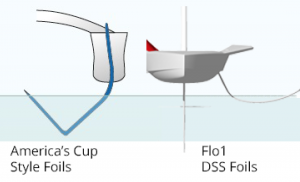Emirates Team New Zealand explored the use of a fully foiling catamaran in 2012 in their preparation for the 2013 America’s Cup. The team found a way of using lifting foils within the America’s Cup rules.
These catamarans were sailed by elite top sailors and required an extensive R&D and sailing team to bring these boats and projects up to speed.
The rule restrictions made it hard for the teams to create a stable flying boat. Fellow Dutchman Simeon Tienpont was part of the winning team Oracle Team USA and was continuously working the daggerboard/foil controls to keep the powerful wing sail catamaran going.
The exciting America’s Cup match between Emirates Team New Zealand and Oracle Team USA, was broadcast on YouTube and sailors and non-sailors across the world were caught by the foiling fever.
Unique and innovative broadcasting techniques were used, which helped gain momentum and popularity outside the sailing world.
Source: America’s Cup
Aeronamics was founded to bring hydrofoil sailing to a large group of sailors. Stability while sailing on foils using a concept like the America’s Cup catamarans creates a naturally unstable situation. Boat heeling and stability are closely linked together and make these boats very hard to sail.
The DSS concept uses a leeward pointing lifting foil. While the main goal is to lift the boat, the foil is a huge stability enhancer as well. In the past DSS technology was developed to increase righting moment and stability and to reduce displacement. Both aspects are being pushed to the maximum in the Flo1. Stability increases when you need it most: when speed increases. Sailing on the leeward board this creates a smooth ride.
The overall platform is designed around the foils. Rig size and position are closely related to the foil size and position. Control lay-outs have been kept as simple as possible, with control lines lead to the hiking area for easy sail control.
– Jurian Rademaker


